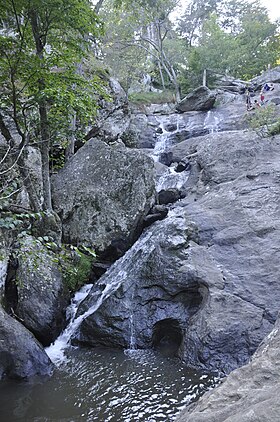Cunningham Falls State Park
| Cunningham Falls State Park | |
| Maryland State Park | |
|
The longest cascading waterfall in Maryland
|
|
| Country | United States |
|---|---|
| State | Maryland |
| County | Frederick |
| Elevation | 1,247 ft (380 m) |
| Coordinates | 39°37′53″N 77°28′17″W / 39.63139°N 77.47139°WCoordinates: 39°37′53″N 77°28′17″W / 39.63139°N 77.47139°W |
| Area | 6,033 acres (2,441 ha) |
| - Wildlands | 4,397 acres (1,779 ha) |
| Established | 1954 |
| Management | Maryland Department of Natural Resources |
| IUCN category | V - Protected Landscape/Seascape |
| Website: Cunningham Falls State Park | |
Cunningham Falls State Park is a state-run, public recreation area located west of Thurmont, Maryland, in the United States. The state park is the home of Cunningham Falls, the largest cascading waterfall in Maryland, a 43-acre (17 ha) man-made lake, and the remains of an historic iron furnace. The park is one of several protected areas occupying 50-mile-long ; it is bordered on its north by and on its south by Frederick Municipal Forest.
Before the arrival of European settlers, Native Americans used the Catoctin Mountain area for hunting and fishing and also quarried it for rhyolite to make projectile points. During the 19th century, settlers began cutting the area's forests for charcoal to power the . "Charcoal flats"—square areas measuring approximately 25 by 25 feet (7.6 by 7.6 m), cut flat into the hillsides and linked by mule trails—were used to build charcoal kilns. The charcoal flats can still be seen in the park.
Over two hundred years of abuse of the forest led to the destruction of the land. In the 1930s, after years of clearcutting for the making of charcoal, mountain farming, and timber harvesting, the land was purchased by the Federal government. Beginning in 1935, workers with the Works Progress Administration and the Civilian Conservation Corps began constructing the Catoctin Recreational Demonstration Area to transform the area for recreational use. The site's northern portion was transferred to the National Park Service on November 14, 1936, and renamed and reorganized on July 12, 1954, as . The southern 5,000 acres (2,000 ha) were transferred to Maryland as Cunningham Falls State Park.
Known locally, as McAfee Falls, after a family of early settlers, 78-foot (24 m) Cunningham Falls was apparently named after a photographer from Pen Mar Park who frequently photographed the falls. West of the falls, on Big Hunting Creek, lies "Dunkards Trough," a natural rock formation within the stream that forms a deep trough used by an early German religious group, the Dunkards, for baptisms.
...
Wikipedia

